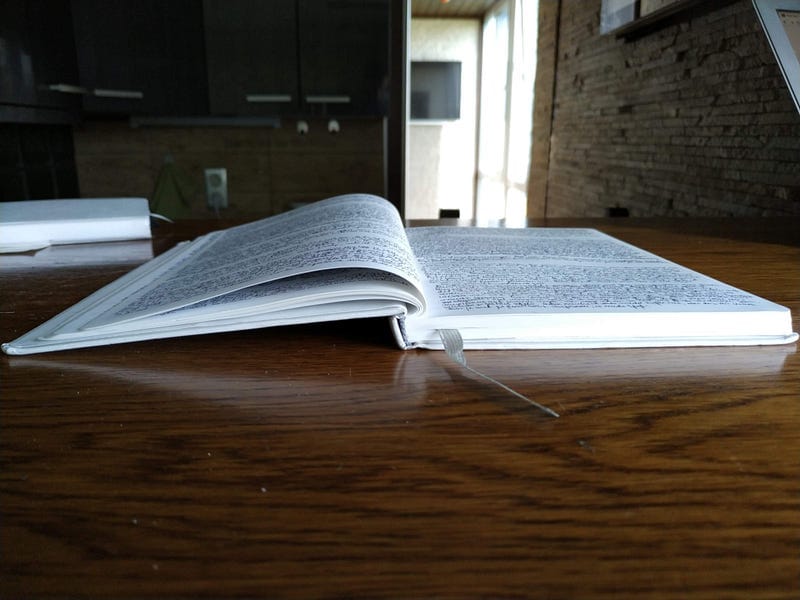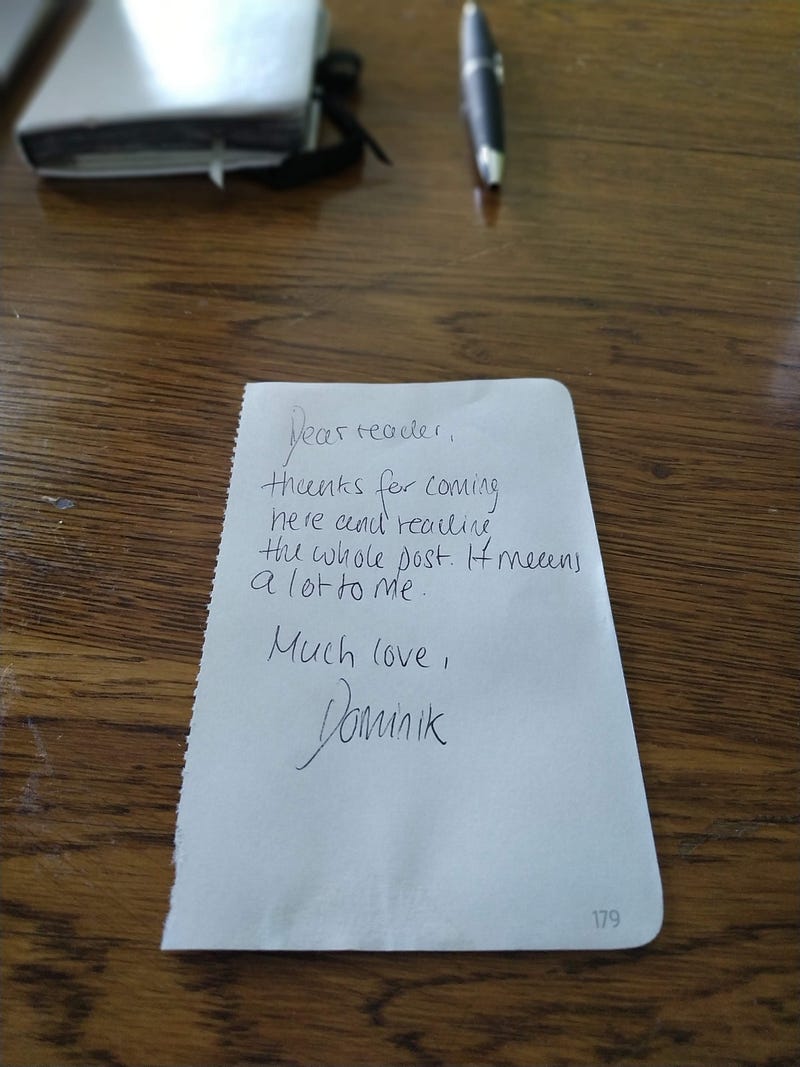Handwriting Is Here To Stay — Here Are 10 Reasons Why
When was the last time you wrote something by hand?

When was the last time you wrote something by hand?
A note scribbled on a post-it doesn’t count. When was the last time you deliberately sat down to write something, on a piece of paper, with a pen?
In an age of computers, smartphones and tablets, writing by hand isn’t necessary anymore. You can type on a keyboard, on a touchscreen, you can even just speak and the computer will write it for you — all more efficient than taking pen and paper to write something down.
And yet, I write by hand every day. I may not be as analogue as my mother, who writes her grocery shopping lists on a notepad — I use Evernote for that. And I certainly don’t hand draw sales pitches, nor do I handwrite my communication on WhatsApp. And no, I don’t handwrite my blog posts either.
I write by hand in my journal every morning. In meetings every day. On thank you notes. Hell, even on my office (glass) walls.
Originally, I planned this article to be just the usual blog post I write. Dump a few personal impressions on Medium, and hope it performs. But then I googled “benefits of writing by hand” and went down the rabbit hole, reading a whole master’s thesis as well as several other papers, articles on the internet and now I feel like a semi-expert on the topic of hand writing.
Here’s what I learned. There are a few things that really surprised me, but when thinking about them, they totally make sense.
Disclaimer: this article is rather long, so if you only have a minute or two, scroll down to the bottom, where I put together a list of six actionable steps to use handwriting in your everyday life.
Handwriting slows everything down.
You could call handwriting the “slow food” of producing text. When you write by hand, you are slower than typing on a keyboard (with a typing speed of 96 WPM on average, I’m way slower by hand). By slowing down, you tend to think more actively about what you’re actually putting to paper.
And this, in turn, fosters creativity. During my daily journaling habit, where I sit down for 20–30 minutes to simply write freely flowing, I have the best ideas. You start looking at things in a different way, thinking about your problems from a different angle.
As William Zinsser, author of “On Writing Well” among others, says: “Writing is thinking on paper.”
—
Handwriting lets you easily dump information.
Whenever I can’t sleep because I’m (over)thinking things, I get up, grab my journal and quickly write down what I’m thinking about.
It’s like an eraser for your brain. Once your thoughts are recorded somewhere, it’s easy for you to let them go.
Journaling accomplishes the same thing. By journaling every day, I am able to dump all the mental baggage in the morning, and to tackle every workday clear-headedly. This, in turn, allows me to focus a lot better.
—
Handwriting shows appreciation.
At our company, we send out German teaching books. A lot of them. Back when I was still responsible for doing that (a highly challenging and rewarding job, I know), I wrote a short note in every single one of them. Why?
Because by taking the time to do that, it shows that you appreciate the person. It’s the right thing to do. A book is so much more worth if it has been personally handed to you.
You can do the same with thank you cards. Sending someone a hand-written thank you card speaks so much louder than simply shooting them a quick email. You actively took the time to write that note, put it in an envelope and throw it into the mailbox. That’s appreciation, and it will come back to you.
—
Handwriting shows respect.
Friday, 14:00. The candidate management team at Linguedo gets together for their weekly review and planning meeting. And everyone brings their laptops, folds them up, and all the sudden you have four people sitting there. The purpose of the meeting is to talk to each other, not to stare at a screen. Yet everyone is bringing their laptops — to take notes.
I find this highly disrespectful. Whether you like it or not, you will eventually be distracted from the conversation by something happening on your laptop. A new message in Slack. A new email. A funny GIF. And by not being there 100%, you’re wasting not just your time, but everyone else’s time.
In meetings, I always try to bring my notepad to write stuff down, and then digitalize it afterwards. You can always track your tasks on paper and then add them to your favorite task management app later; no need to do that right away.
Writing by hand shows respect, in two ways: first, you’re fully focused on the meeting, because there are no distractions. Second, by actively taking notes, you acknowledge the fact that what is being said is important to you.
Next time you bring your laptop, remember — it’s okay to bring your laptop for the purpose of showing data, charts etc., but not for taking notes. And yes, it might take longer to digitalize them afterwards, but it’s definitely worth the time. And you’ll retain the information conveyed much longer.
—
Handwriting helps you retain memory better.
Typing allows you to transcribe things verbatim, so you can simply write down what is being said. When writing by hand, you cannot possibly write that fast, so you have to cluster and process the information while taking it in. According to Mueller & Oppenheimer, typing vs. handwritten note taking does not make a difference in factual recall, but makes a huge difference in applying the concepts. When typing, your brain is just “mindlessly transcribing”; when writing, your main is already making the connections and thus able to apply the concepts better.
Handwriting therefore leads to higher quality learning, the researchers say — and better retention of information and concepts.
So one quick hack to get your academic performance up — or to learn anything better — is to simply start taking notes by hand. It might just be that easy.
—
Handwriting improves focus.
In our digital world, we’re constantly working on connected devices. I’m currently writing this article on my MacBook Air, have approximately 187 tabs open, WhatsApp Web is running (a super bad habit of mine, I know), and in between researching and writing, I’m answering organizational questions as well as developing a new idea for a social business. Not a great start to thorough focus or “deep work”.
Now, when you write by hand, all that stuff is gone. It’s you, your pen, and the paper. Nothing else to be distracted by. When I write by hand, I’m super focused and super creative. When I’m typing, I need to re-create the same circumstances — but that’s a lot harder.
And it gets even better. The ability to focus is a meta-skill, which you can apply to different contexts. Just like your ability to learn a new skill increases with every new skill that you learn (learning your first foreign language is a lot harder than your fifth, I can tell you), your ability to focus increases with every minute spent in deep focus.
Therefore, the focus you exert when writing by hand will help you in turn to focus better in other contexts — whether it is at work, during sports, meditation or even in social settings.
Quick aside: social settings? Yes, focus matters there too. When you have a conversation, try being 100% focused on that conversation, not checking the environment, not trying to check your phone, not being distracted by other things surrounding you. It’s hard, really hard. But it shows a great deal of respect for the other person when you’re truly focused on the conversation.
—
Handwriting increases the GDP of developing countries.
Handwriting teaches literacy. Writing and reading skills correlate closely. Therefore, the more you write, the better you will become at reading. Since you’re reading this post, I assume you are fully capable of reading and writing; but for many people in this world, this is not the case.
Being able to read is the key to education. How will you retain information if you cannot read it properly nor record it? You probably won’t — and thus not be able to work in a lot of jobs, not be able to be informed about political happenings, and in general cut off from a lot of society. And while we think that in developed countries, everyone has these abilities, it’s simply not true.
In Germany alone there are 7.5 million people (!) between 18 and 64 who are “functionally illiterate”, according to this article (alternative source). There are roughly 50 million people in Germany between 18 and 64, so that’s a whopping 15% of the population. But nobody talks about it — it’s a taboo topic.
And that’s just Germany. In the whole world, there are 774 million people who are illiterate (how that is distinguished from “functionally illiterate”, I don’t know). Take a second to think about what that means — all those people aren’t able to receive proper education, to work and create value. Many problems in this world could be solved by simply being literate. One bright spot is that at least the younger generations are mostly literate, but this is still a problem worth solving.
—
Handwriting saves lives.
Bad handwriting literally kills people. I’m borrowing a lot in this article from Saara Helkala’s master’s thesis — there she quotes a report that approximately 7,000 patients in the US die every year because of bad handwriting.
As someone who spends a lot of time in hospitals (our startup builds the bridge between unemployed nurses in Southern Europe and German hospitals yearning for more personnel), I can attest to that. Looking at a few medication slips, I can often only guess what is written on there. Luckily, most nurses are competent enough to interpret what is needed for the patient, so errors are relatively few. But still, 7,000 lives taken because your handwriting sucks? C’mon man. That’s an easy fix, isn’t it?
—
Handwriting improves hand-eye coordination.
When you write by hand, you’re exerting force on an object in a very accurate manner. You’re not doing the macro-motion of throwing a ball, but making tiny movements in order to draw circles on paper. According to an article by Mark Mont-Williams, this has a high impact on hand-eye coordination and related activities, such as playing ball sports, using cutlery or tying shoelaces. Might not be that important for adults anymore, but it’s highly important for children’s development. And for anyone trying to pick up a sport with high hand-eye coordination, such as Lacrosse.
—
Handwriting has great UX design.
“I believe that things with a great user interface survive better”, Finnish neuroscientist Minna Huotilainen says in Helkala’s thesis.
You gotta give it her — the user experience of writing with pen and paper is pretty damn great. It’s just so easy. You don’t need to open anything, no clumsy typing on a way-too-small touch screen, just grab your pen and go. It’s pretty flawless.
Therefore, handwriting probably won’t come totally out of fashion, especially since it’s been around for thousands of years.
“Okay Dominik, handwriting is awesome, I get it. But how do I put it into practice?”
I can’t read your mind, but maybe / hopefully that’s what you’re thinking. Based upon the above statements, here’s a few things you can do:
- When learning something, don’t take notes on your laptop — do it by hand instead. It’ll increase your quality of learning as well as your ability to apply conceptual information. And it might just make your grades a lot better.
- In meetings, take your notes by hand and digitalize them afterwards. Your meeting partners will thank you, and you will thank yourself, because you remembered all the information conveyed there.
- Send a hand-written thank you card every now and then. It takes 5 minutes, but may mean the world to the recipient. And if you’re in account management, it certainly helps with customer retention. ;)
- Start a daily journaling habit. It doesn’t need to be 20–30 minutes, it can also only be 5. Because you will realize that once you start writing, you won’t stop after 5 minutes, when the ideas start flowing. It’s an awesome creative process, and I get a lot of benefits from it.
- Put a notepad by your bedside and when you can’t sleep, simply write down what’s going through your head. This will help, trust me. And better sleep makes us a better person.
- Get a high quality writing toolkit. I use a Karst Stone Paper notebook and a Lamy pen, but any high quality journal and pen will do. I just really like the feel of the stone paper. And no, I don’t get paid for promoting them — I just think their products are awesome!
Writing by hand is an underrated and under-utilized skill in my opinion, yet it boasts so many advantages to typing. That is not to say that typing is bad, quite the opposite — it’s a great tool for many purposes, just not for every purpose.
In the end, that’s what writing by hand is — a tool. It has its applications, but there are also cases where it’s not very useful (for instance, for quickly replying to email conversations). Use it, but use it true to its purpose.
Give it a try. Use one or two of the things mentioned above, and see what happens. I hope you’ll like the results.
Until then, here’s a written thank-you note from me for you:

Thanks!
Liked this blog post? I’d be more than thrilled to hear from you — let me know in the comments, or shoot me an email at hello@dominiknitsch.com. I read every single one of them.
I also have a newsletter, in which I write short takeaways for every book that I read, and share all my posts. Simply subscribe to my newsletter here.
PS: All subscribers get instant access to all new blog posts, even without a Medium subscription.
Literature:
I’ll write you a note ✍ WHY WRITING BY HAND WILL BE RELEVANT IN THE FUTURE? (Helkala, S., 2017)
Learning handwriting is more about training the brain than cursive script (Mont-Williams, M., 2015).
Dominik Nitsch Newsletter
Join the newsletter to receive the latest updates in your inbox.


